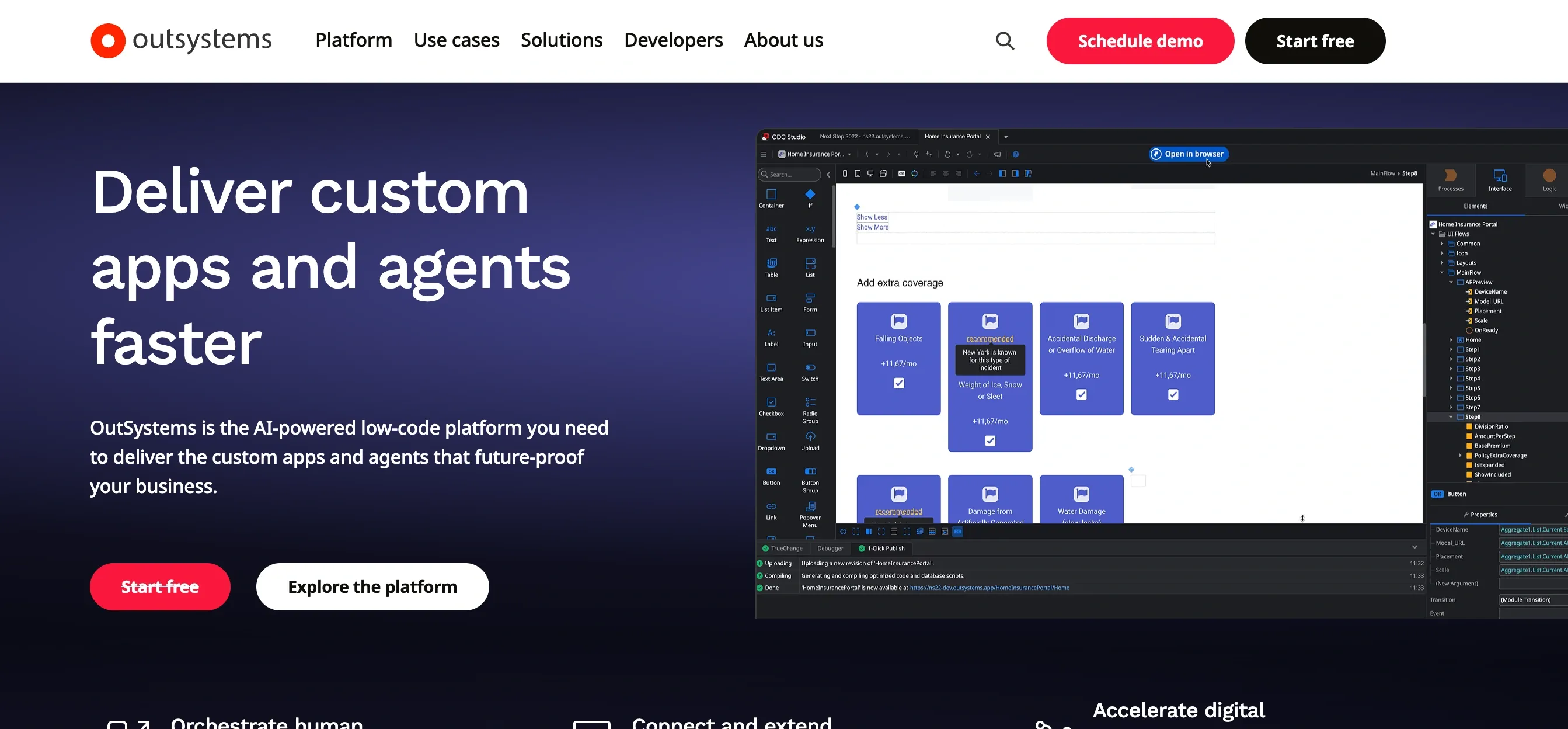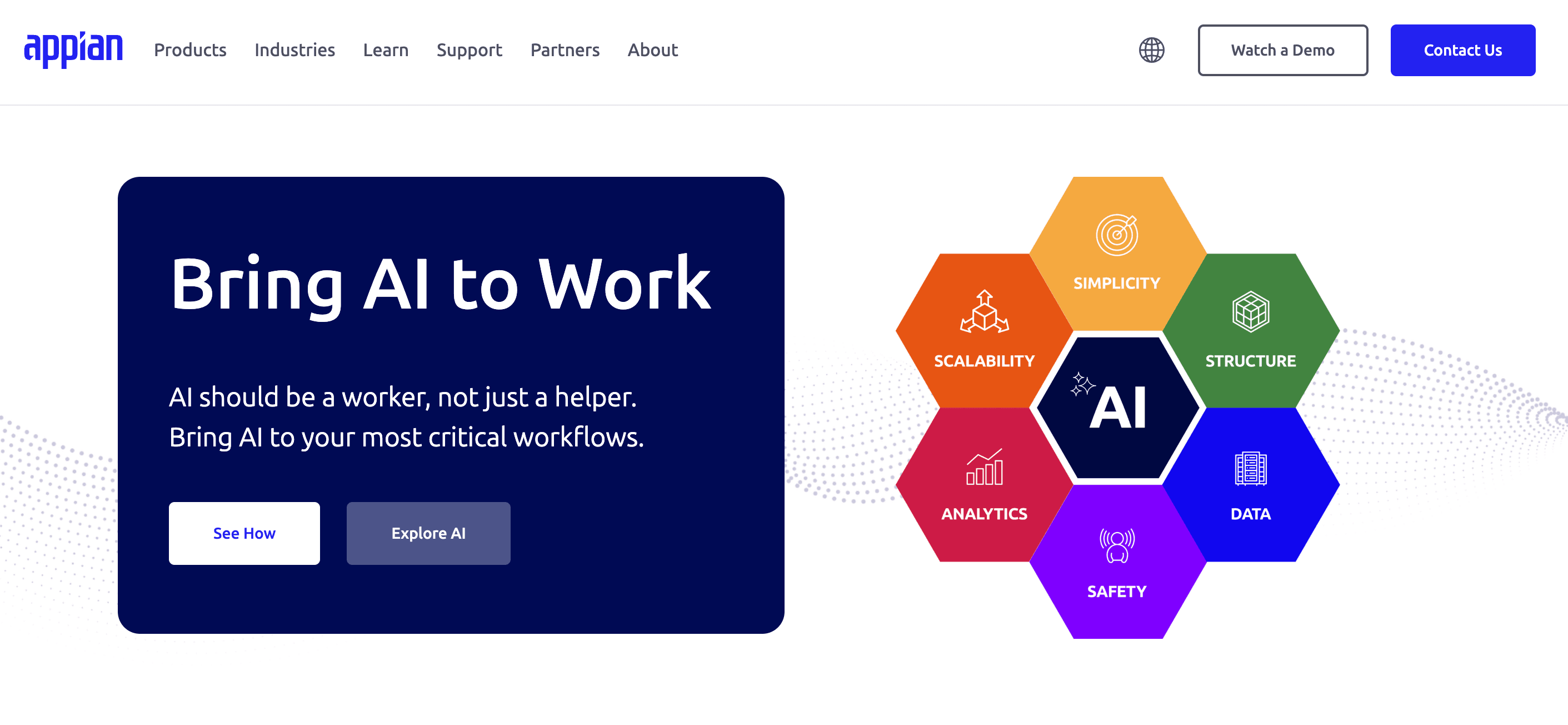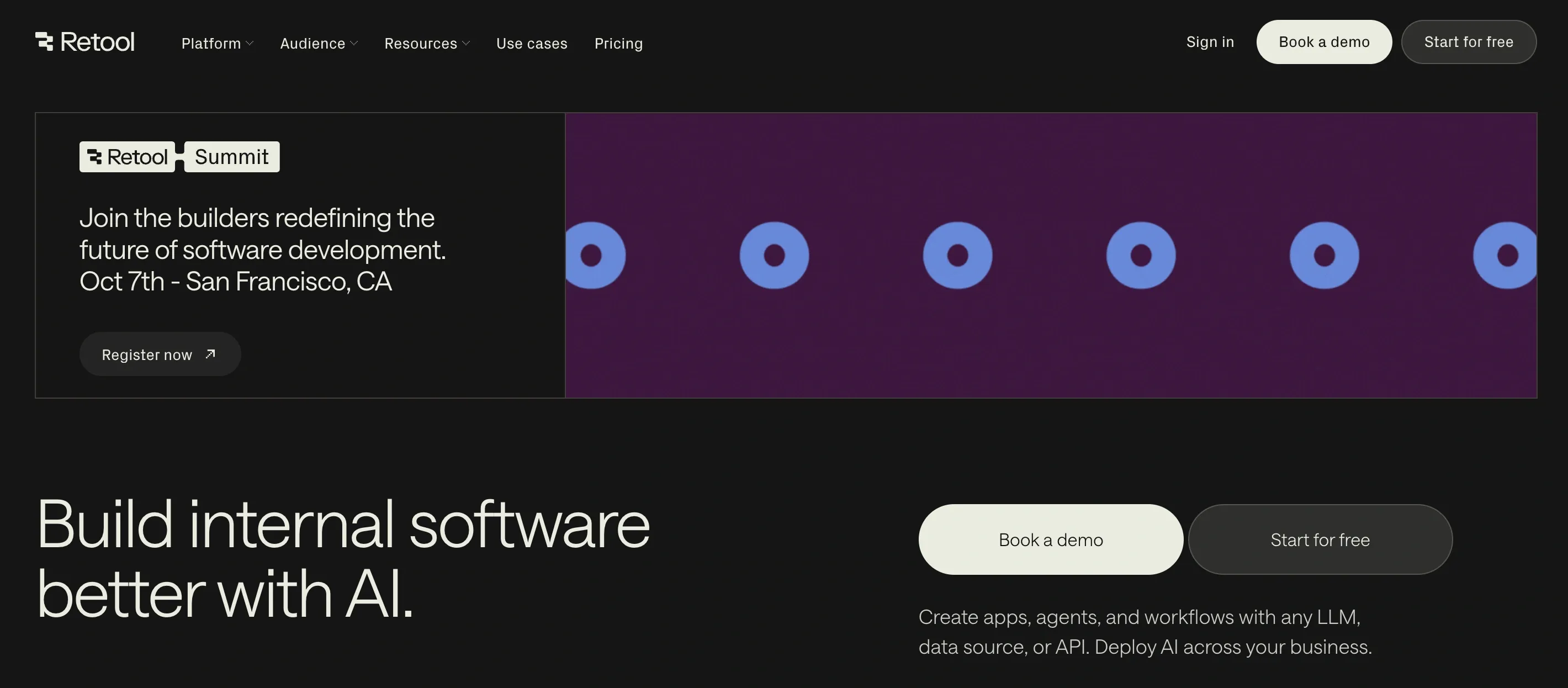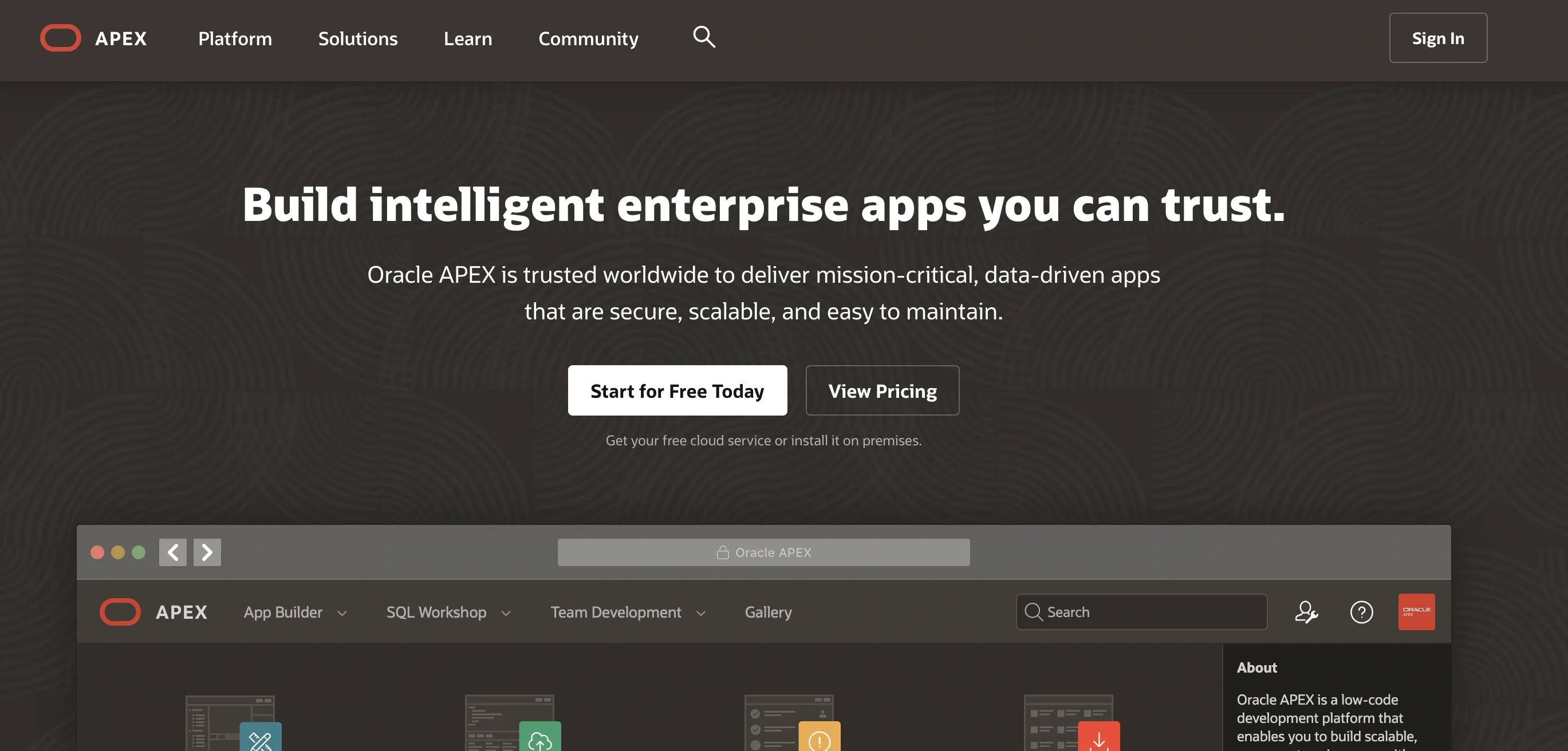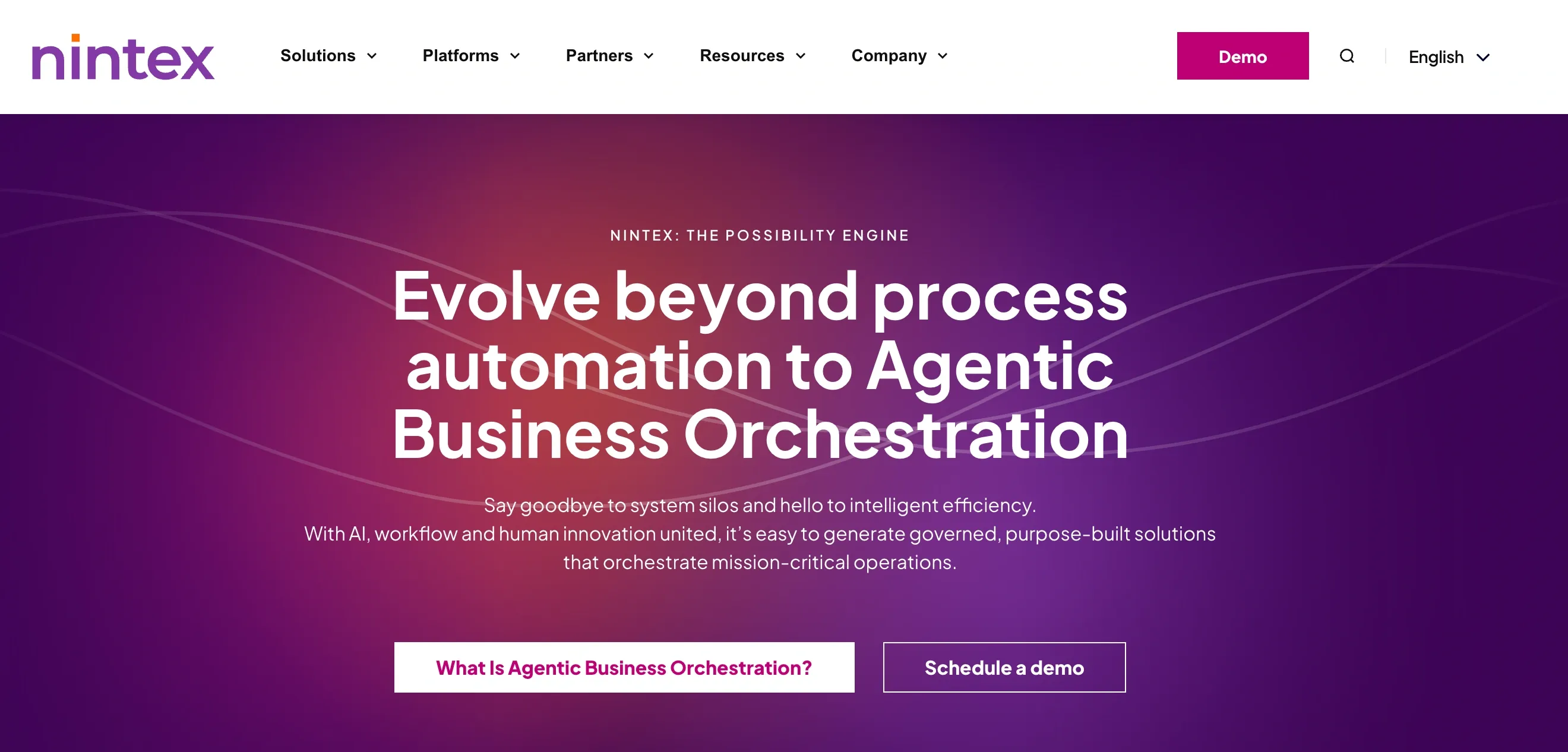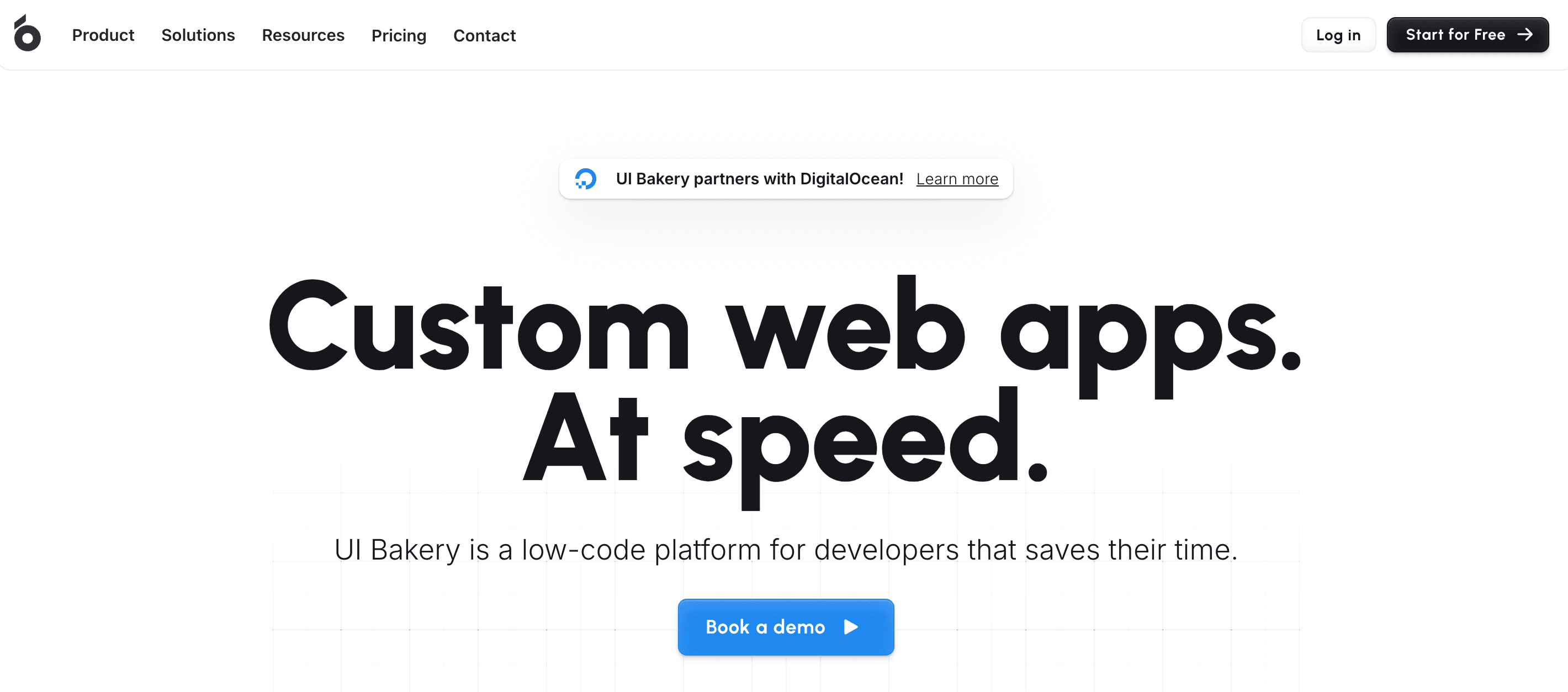10 Best Low-Code Development Platforms For Web & Mobile Apps
Date
Mar 20, 25
Reading Time
10 Minutes
Category
Other

Low-code platforms have become essential for businesses that need to build apps quickly without relying on long development cycles. In 2025, both startups and enterprises are opting for low-code solutions to launch products, automate workflows, and scale digital services more quickly.
Here are the 10 best low-code platforms for building applications in 2025, ranked by adoption, features, and overall industry impact.
10 Best Low-Code Development Platforms
1. Joget DX
Rating: ⭐⭐⭐⭐ (4.0/5)
Joget DX is an open-source low-code/no-code platform that unifies workflow, business process automation, and app development. It’s known for its flexibility and cost-effective entry point, making it attractive for mid-sized businesses and government use cases.
Features
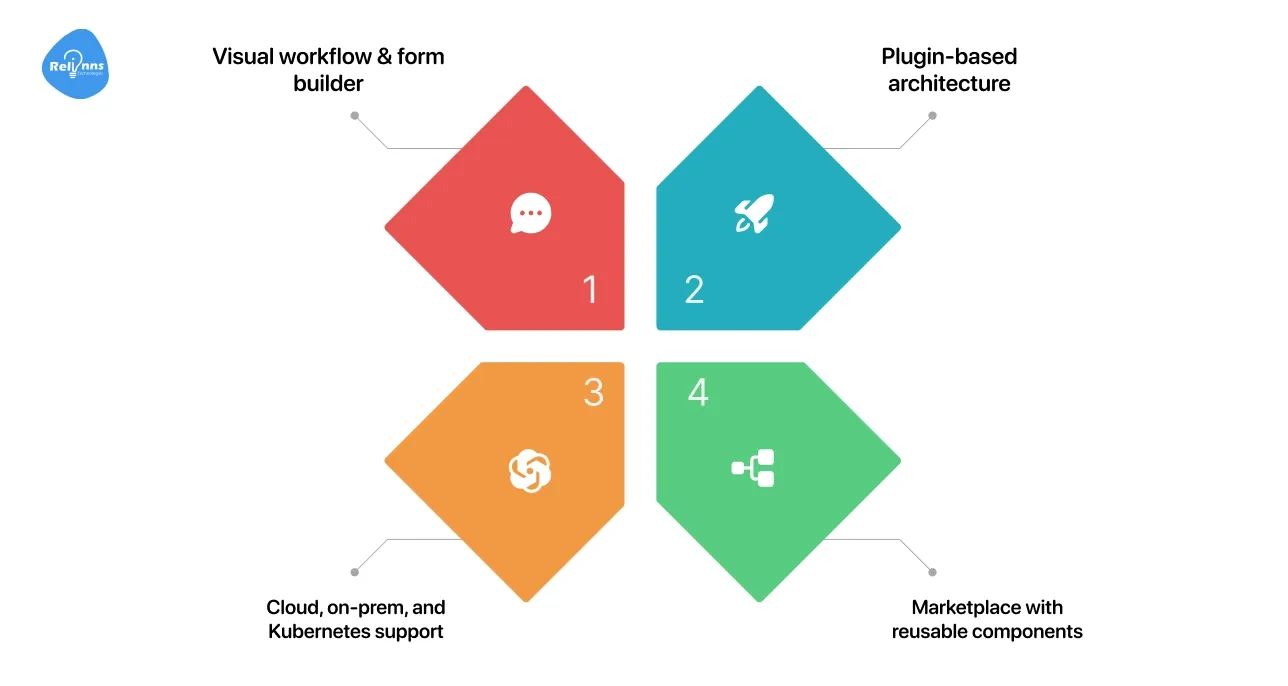
- Visual workflow & form builder
- Plugin-based architecture
- Open-source Community Edition
- Cloud, on-prem, and Kubernetes support
- Marketplace with reusable components
Pros & Cons
| Pros | Cons |
| Open-source, cost-effective | UI/UX flexibility is limited compared to modern rivals |
| Strong BPM and automation features | Learning curve for advanced features |
| Flexible deployment (cloud, on-prem, hybrid) | Smaller ecosystem and community than larger vendors |
Pricing
- Free Community Edition
- Enterprise license from ~US$120/user/year (custom options available)
2. OutSystems
Rating: ⭐⭐⭐⭐ (4.4/5)
OutSystems is a leader in enterprise low-code platforms, known for its scalability and robust feature set. It supports large-scale digital transformation projects with strong DevOps, security, and multi-platform deployment capabilities.
Features

- Drag-and-drop app designer
- Multi-platform deployment (web & mobile)
- AI-powered automation
- Real-time performance monitoring
- Strong governance controls
Pros & Cons
| Pros | Cons |
| Ideal for complex, enterprise projects | Expensive licensing |
| Advanced integration and API support | It can be overwhelming for small teams |
| Excellent DevOps and scalability | Requires training for full use |
Pricing
- Free developer plan
- Enterprise plans start from ~US$4,000/month (custom pricing available)
Suggested Reading: Joget vs OutSystems: Best Low-Code Platform for Enterprises
3. Microsoft Power Apps
Rating: ⭐⭐⭐⭐(4.2/5)
Microsoft Power Apps makes it simple for businesses already using Microsoft 365, Azure, and Dynamics to create apps and automate workflows. It’s popular with enterprises that want fast development within a familiar ecosystem.
Features
- Prebuilt templates
- 500+ connectors
- AI Builder integration
- Microsoft Teams & Office 365 integration
- On-prem and cloud deployment
Pros & Cons
| Pros | Cons |
| Seamless Microsoft ecosystem integration | Licensing can be complex |
| Quick development for internal tools | Limited flexibility for advanced UI |
| Strong community and support | Scaling can increase costs |
Pricing
- Free/basic plan available
- Premium plans from ~US$20/user/month
4. Appian
Rating: ⭐⭐⭐⭐ (4.1/5)
Appian is a trusted platform for large organisations that need automation, case management, and enterprise-grade compliance. It blends low-code with process automation and RPA capabilities.
Features
- Workflow & case management
- Robotic Process Automation (RPA)
- AI-powered decisioning
- Data fabric integration
- Enterprise compliance & security
Pros & Cons
| Pros | Cons |
| Great for regulated industries (finance, healthcare) | Higher cost barrier |
| Advanced process automation | Steep learning curve |
| Scalable and enterprise-ready | UI customisation is limited |
Pricing
- Custom enterprise pricing
- Typically starts at ~US$90/user/month
5. Pega Platform
Rating: ⭐⭐⭐⭐ (4.0/5)
Pega is an established low-code leader in workflow, CRM, and business process management. It’s a top choice for large enterprises that need advanced automation and decision management.
Features
- Case management
- AI-driven decision automation
- End-to-end workflow orchestration
- CRM integration
- Multi-deployment (cloud & on-prem)
Pros & Cons
| Pros | Cons |
| Best for complex enterprise workflows | Expensive for smaller companies |
| Powerful AI and rule management | Complex setup and training required |
| Strong compliance & governance tools | UI flexibility is limited |
Pricing
- Subscription-based
- Enterprise pricing varies by scale
Suggested Reading: Kissflow vs Joget Workflow Comparison
6. Mendix
Rating: ⭐⭐⭐⭐(4.5/5)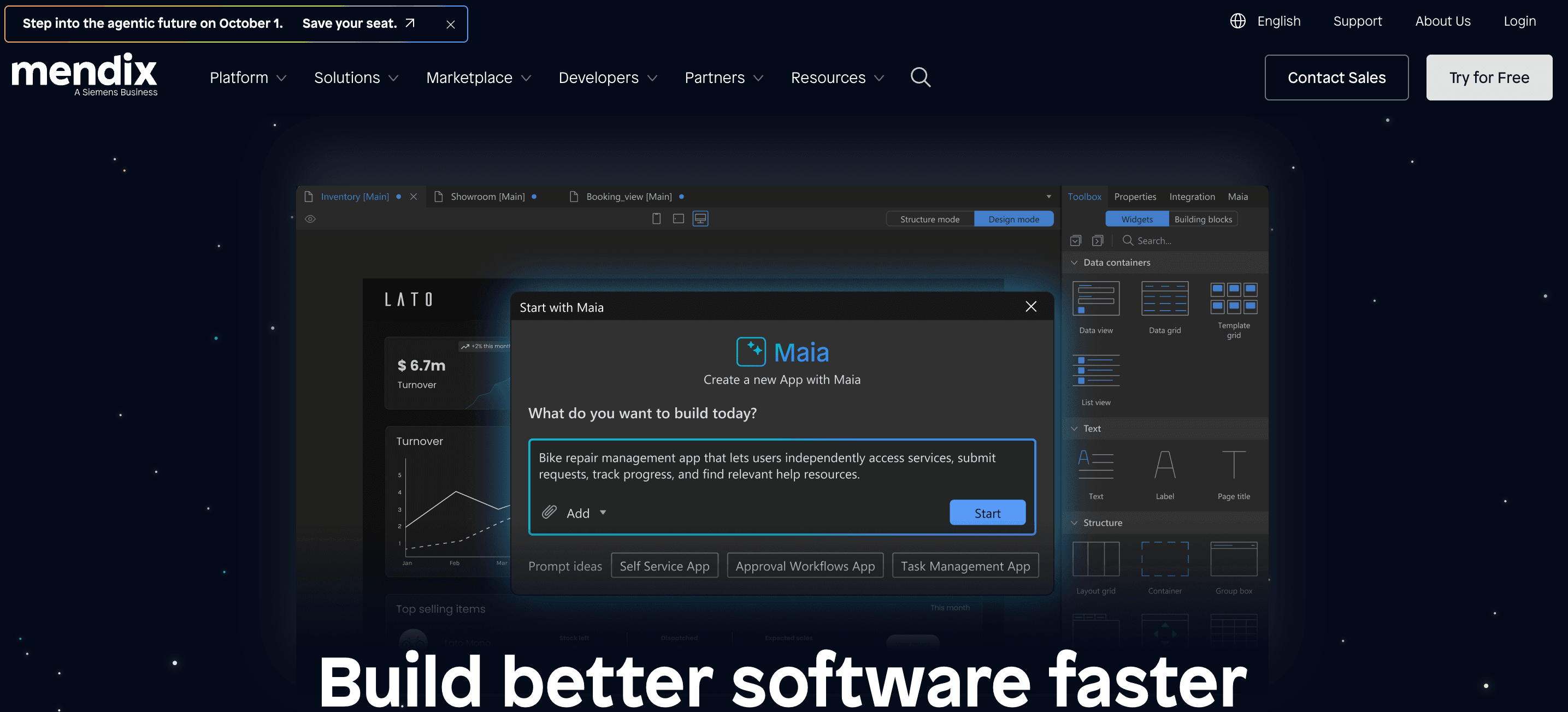
Mendix is one of the most widely adopted low-code platforms for enterprises. It combines ease of use for business users with advanced tools for developers. Companies use Mendix for everything from customer portals to large-scale enterprise apps.
Features
- Visual development environment
- AI-assisted development
- Multi-experience (web, mobile, chatbots)
- Advanced data integration
- Enterprise governance
Pros & Cons
| Pros | Cons |
| Highly scalable and enterprise-ready | Pricing can be high for SMBs |
| Large ecosystem and community support | Steeper learning curve for beginners |
| Flexible integrations with APIs and systems | Complex licensing model |
Pricing
- Free plan available
- Standard plans from ~US$50/user/month
- Enterprise pricing is custom
7. Retool
Rating: ⭐⭐⭐⭐ (4.2/5)
Retool is tailored for developers who need to rapidly build internal tools and dashboards. It combines drag-and-drop components with the flexibility to write custom code when needed.
Features
- Pre-built UI components
- API & database connectors
- Role-based access control
- Version control integration
- Fast prototyping tools
Pros & Cons
| Pros | Cons |
| Ideal for internal dashboards and CRUD apps | Less suited for consumer-facing apps |
| Developer-friendly with JS customization | Costs rise with user scaling |
| Quick to launch prototypes | Limited advanced UI polish |
Pricing
- Free plan available
- Paid plans from US$12–50/user/month
- Enterprise pricing on request
8. Oracle APEX
Oracle APEX is a low-code platform tightly integrated with Oracle Database. It’s optimised for building secure, data-driven apps, particularly for enterprises already using Oracle infrastructure.
Features
- Visual app builder
- SQL & REST data integration
- Built-in reporting & dashboards
- Security and compliance features
- Cloud & on-prem hosting options
Pros & Cons
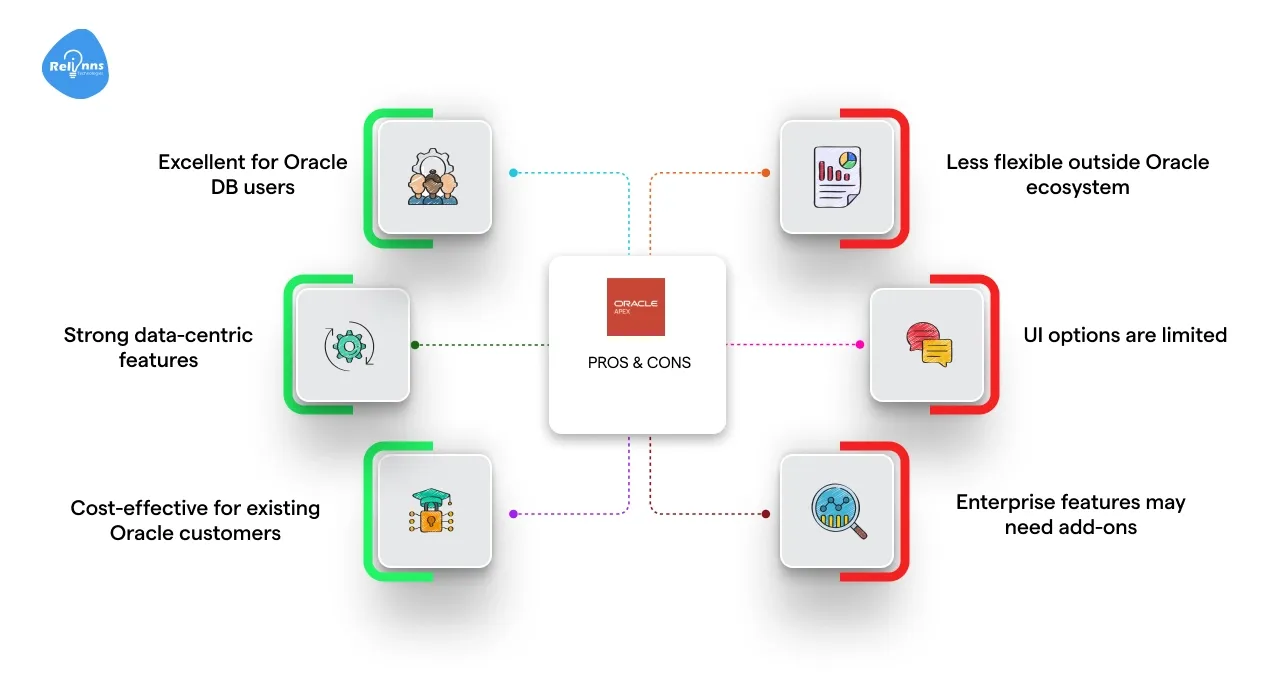
| Pros | Cons |
| Excellent for Oracle DB users | Less flexible outside Oracle ecosystem |
| Strong data-centric features | UI options are limited |
| Cost-effective for existing Oracle customers | Enterprise features may need add-ons |
Pricing
- Free tier available
- Paid plans from ~US$122/month on Oracle Cloud
9. Nintex
Rating: ⭐⭐⭐ (3.9/5)
Nintex is a low-code automation platform focused on workflow and process management. It’s widely used in enterprises to streamline repetitive processes and improve efficiency.
Features
- Workflow automation
- Robotic process automation
- Document generation
- Advanced analytics
- Integration with Microsoft & Salesforce
Pros & Cons
| Pros | Cons |
| Strong workflow & automation features | Pricing can be steep |
| Good integration with Microsoft 365 & Salesforce | Limited advanced app development flexibility |
| Reliable support and training resources | Best suited for process automation, not broad app development |
Pricing
- Subscription-based
- Pricing available on request (depends on users & usage)
10. UI Bakery
Rating: ⭐⭐⭐⭐ (4.0/5)
UI Bakery is a modern low-code platform for building internal tools and dashboards. It focuses on speed, simplicity, and visual design flexibility.
Features
- Drag-and-drop UI builder
- Prebuilt templates & components
- REST & database integrations
- Role-based permissions
- Custom code support
Pros & Cons
| Pros | Cons |
| Great for clean internal apps & dashboards | Limited for large enterprise apps |
| Affordable for startups & SMBs | Smaller ecosystem & community |
| Simple and intuitive UI builder | Lacks deep automation tools |
Pricing
- Free plan available
- Paid plans from ~US$5/user/month
How to choose a low-code platform?
To choose a low-code platform, focus on your project needs, preferred integrations, and how user-friendly the interface is for your team. Compare security, scalability, and pricing models, and check user reviews to gauge real-world performance. Opt for a platform that balances customization, support, and fits your long-term business goals.
To choose the right low-code platform, focus on:
- Your use case – internal tools, customer apps, workflows, or enterprise systems.
- Ease of use vs. flexibility – pick a tool that matches your team’s technical skills.
- Integrations – ensure it connects smoothly with your databases, APIs, and existing software.
- Scalability & performance – check if it can grow with your business needs.
- Pricing & support – review costs, licensing models, and available community or vendor support.
How does Relinns help in low-code development with these tools?
Relinns supports businesses by providing expert consultation, customized development, and integration services for leading low-code platforms. Whether it’s Mendix, OutSystems, or Joget DX, Relinns helps tailor solutions that fit specific workflows and technical ecosystems, accelerating digital transformation efforts.
Additionally, Relinns offers training, maintenance, and ongoing support to ensure your low-code apps remain scalable, secure, and aligned with evolving business needs. This comprehensive approach lowers risks, reduces time-to-market, and maximizes ROI from your low-code investments.
Conclusion
Low-code platforms are revolutionizing application development for businesses of all sizes. By offering visual tools, ready integrations, and scalable options, they help organizations innovate quickly and stay agile.
When selecting a low-code platform, focus on use case compatibility, integration ability, customization options, pricing, and long-term scalability. This careful approach ensures your investment will deliver lasting value and support your growth.
Ultimately, the key to successful adoption is matching platform strengths with your project goals and involving both IT and business teams in the decision process.
Frequently Asked Questions (FAQ's)
What are the must-have features of low-code platforms?
Must-have features include visual drag-and-drop builders, prebuilt templates, AI-assisted development, strong integration capabilities, scalability, and enterprise-level security.
What types of applications can be built with low-code platforms?
Low-code platforms enable the development of internal tools, customer portals, workflow automations, mobile apps, and complex enterprise applications tailored to specific business needs.
How secure are low-code platforms?
Low-code platforms ensure security through authentication, authorization, data encryption, and compliance measures to safeguard data and applications.
How do low-code platforms integrate with existing systems?
They integrate using APIs, prebuilt connectors, and data tools, enabling seamless real-time data exchange and interoperability across multiple systems.



